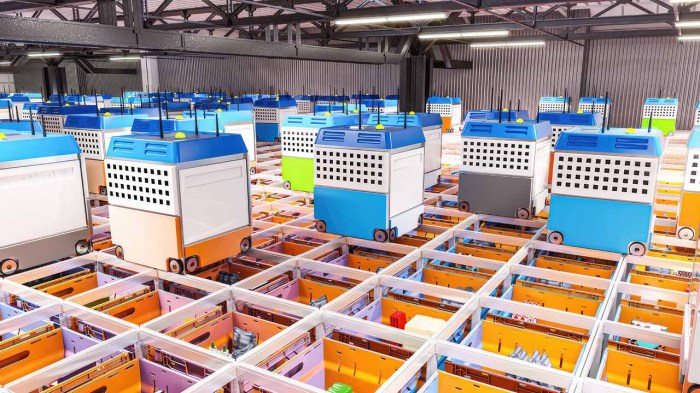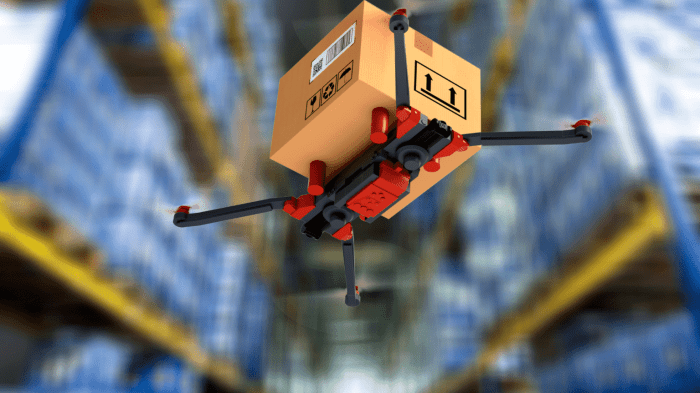
Warehouse automation is revolutionizing the logistics landscape, serving as a crucial driver in modern supply chain management. With the rapid advancement of technology, businesses are now able to streamline their operations, enhance productivity, and improve accuracy in their warehouse processes. As we delve into the evolution of these automation systems, we will uncover how they have reshaped the way goods are stored, managed, and distributed.
From incorporating robotics and artificial intelligence to leveraging data analytics, warehouse automation has significantly transformed traditional practices. This shift not only addresses the growing demands of e-commerce but also positions companies to compete effectively in a fast-paced marketplace. Understanding its key components and functionalities is essential for any business aiming to thrive in today’s economy.
Introduction to Warehouse Automation

Warehouse automation refers to the use of technology and systems to streamline and enhance the efficiency of warehouse operations. In an era where speed and accuracy are paramount, automation plays a significant role in modern supply chain management. By minimizing human intervention and employing advanced technologies, businesses can optimize their inventory management, reduce operational costs, and improve service levels.The evolution of warehouse automation technologies can be traced back to the introduction of basic mechanized systems, such as conveyors and pallet jacks, which aimed to speed up manual processes.
As technology advanced, more sophisticated systems emerged, including automated guided vehicles (AGVs), robotic picking systems, and integrated warehouse management software. These innovations have transformed warehouses from simple storage spaces into highly efficient, automated hubs capable of handling complex logistics demands with precision.
Key Components of Warehouse Automation Systems
Understanding the critical components of warehouse automation systems is essential for any business looking to enhance its operational efficiency. Each component plays a unique role in ensuring that warehouse processes are seamless and efficient. The following are the main components of these systems:
- Automated Storage and Retrieval Systems (AS/RS): These systems use automated cranes and shuttles to store and retrieve products from designated locations within the warehouse, significantly reducing the time and labor required for manual handling.
- Robotic Picking Systems: Robots equipped with advanced sensing and navigation technologies can pick items from shelves with high accuracy and speed, minimizing errors and labor costs.
- Warehouse Management Systems (WMS): Software solutions that manage inventory levels, track stock movements, and optimize picking and shipping processes. A WMS integrates various operations, offering real-time data and insights.
- Automated Guided Vehicles (AGVs): These driverless vehicles transport goods around the warehouse, following predefined paths and utilizing sensors to avoid obstacles. AGVs enhance safety and efficiency in material handling.
- Sorting Systems: Automated sorting systems quickly categorize and direct packages to their appropriate destinations within the warehouse, enhancing throughput and reducing manual sorting time.
Each of these components contributes to the overarching goal of warehouse automation: to create a highly efficient, responsive, and error-free operational environment that meets the growing demands of modern supply chains.
Benefits of Warehouse Automation
Warehouse automation has transformed the way businesses manage their logistics and inventory processes. By integrating advanced technology, companies can streamline operations, enhance productivity, and significantly cut costs. The shift towards automation is not just a trend; it’s a strategic move that can result in substantial competitive advantages in today’s fast-paced market.Implementing warehouse automation leads to numerous advantages that can reshape operational dynamics.
One of the foremost benefits is the remarkable increase in efficiency. Automated systems like conveyor belts, robotic pickers, and warehouse management software reduce manual labor, minimize human error, and accelerate order fulfillment processes. The integration of these technologies enables businesses to handle larger volumes of goods while maintaining accuracy and speed, which is vital in meeting customer demands.
Improved Efficiency and Reduced Operational Costs
The correlation between warehouse automation and operational efficiency is undeniable. By replacing manual tasks with automated solutions, businesses can optimize their workflows. Below are key advantages that highlight how automation enhances efficiency and reduces costs:
- Faster Order Processing: Automated systems can pick, pack, and ship orders with unmatched speed, reducing turnaround times and increasing throughput.
- Reduction in Labor Costs: With fewer employees needed for manual tasks, companies can lower overhead costs significantly while reallocating human resources to more strategic roles.
- Minimized Errors: Automation reduces the chances of human errors in inventory management, leading to fewer returns and dissatisfied customers.
- Better Space Utilization: Automated storage solutions maximize warehouse space, allowing for more efficient organization and easier access to inventory.
- Data-Driven Decision Making: Automation provides real-time data analytics, allowing businesses to make informed decisions, optimize inventory levels, and forecast demand more accurately.
Several companies have successfully harnessed the power of warehouse automation and witnessed significant improvements in their operations. For instance, Amazon employs a range of automated technologies, including Kiva robots for picking items, resulting in faster delivery times and drastically increased operational capacity. Similarly, Walmart has implemented automated fulfillment centers that enhance inventory management efficiency, cutting costs while ensuring product availability.
These real-world examples underscore the tangible benefits of embracing automation in warehouse settings.
“Warehouse automation is not just about technology, but about transforming how businesses operate and compete in the marketplace.”
Commercial Applications of Warehouse Automation
Warehouse automation has transformed several commercial sectors by streamlining operations, reducing costs, and improving service quality. Businesses across various industries are increasingly adopting automated solutions to enhance their efficiency and responsiveness to market demands. This has led to significant advancements in the way inventory is managed, orders are fulfilled, and overall operational workflows are structured.
Industries Benefiting from Warehouse Automation
Numerous sectors have embraced warehouse automation to gain a competitive edge. These include:
- Retail: Retail businesses leverage automation for efficient stock management, expedited order processing, and improved customer service.
- Manufacturing: Manufacturing firms utilize automated warehouses for streamlined production lines and just-in-time inventory, ensuring materials are available precisely when needed.
- Pharmaceuticals: Automated systems in pharmacies facilitate strict inventory control, compliance with regulatory standards, and quick fulfillment of prescriptions.
- Food and Beverage: Automation assists in maintaining freshness and traceability, enabling faster order fulfillment and reduced spoilage.
- E-commerce: Online retailers benefit from automation through faster order processing and enhanced accuracy in inventory management.
Enhancement of Customer Service and Order Fulfillment
Warehouse automation significantly enhances customer service and order fulfillment processes, resulting in higher customer satisfaction and loyalty. The use of automated systems allows for:
- Faster Processing: Automated sorting and picking systems reduce the time taken to fulfill orders, allowing businesses to offer same-day or next-day delivery options.
- Increased Accuracy: Automation minimizes human error in order picking, ensuring that customers receive the correct products in the right quantities.
- Real-time Inventory Updates: Automated inventory management provides up-to-date stock information, helping businesses prevent stockouts and manage backorders effectively.
“Investing in warehouse automation leads to improved operational efficiency and enhanced customer experiences, ultimately driving business growth.”
Return on Investment for Warehouse Automation Technologies
Investing in warehouse automation technologies can yield significant returns for businesses. The ROI is often realized through various avenues, including:
- Cost Reduction: Automation reduces labor costs by minimizing the need for manual handling, leading to substantial savings over time.
- Enhanced Productivity: Automated systems operate continuously and efficiently, increasing throughput and allowing for greater scalability as demand fluctuates.
- Decreased Errors: A reduction in pick errors translates to fewer returns and customer complaints, saving on logistics costs and enhancing brand reputation.
Real-life examples illustrate this ROI. For instance, a leading e-commerce company reported a 30% increase in order fulfillment speed and a 20% reduction in labor costs after implementing automated picking solutions. Such compelling data highlights the effectiveness of warehouse automation in driving profitability and operational excellence.
Final Conclusion

In conclusion, warehouse automation stands as a pivotal element for businesses seeking growth and operational excellence. By embracing these advanced technologies, companies can drive efficiency, reduce costs, and elevate customer satisfaction. As we move forward, it will be fascinating to witness how further innovations in warehouse automation will continue to shape the future of logistics, potentially unlocking new levels of productivity and service quality.
Essential Questionnaire
What is warehouse automation?
Warehouse automation refers to the use of technology to automate warehouse operations, including inventory management, order fulfillment, and shipping processes.
How does warehouse automation improve accuracy?
By minimizing human intervention and utilizing precise technology, warehouse automation reduces errors in inventory tracking and order picking.
What types of technologies are used in warehouse automation?
Common technologies include robotic systems, automated guided vehicles (AGVs), barcode scanners, and warehouse management software.
Is warehouse automation suitable for small businesses?
Yes, warehouse automation can benefit businesses of all sizes by improving efficiency and scaling operations, although costs and implementation strategies may vary.
What is the ROI for investing in warehouse automation?
The ROI can vary, but many companies see a significant return through cost savings, increased productivity, and improved customer satisfaction within a few years of implementation.





